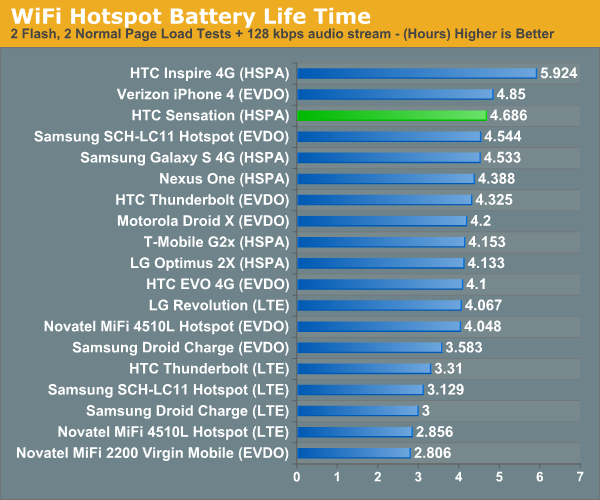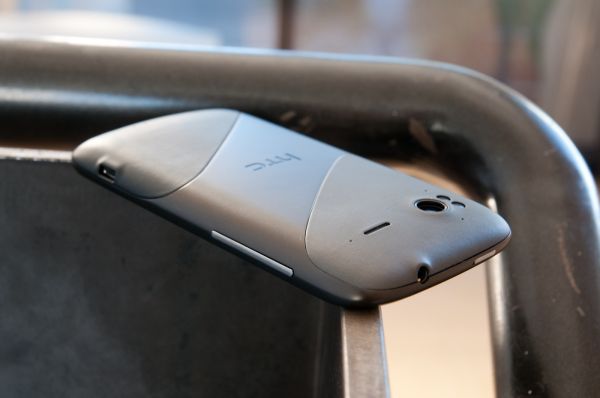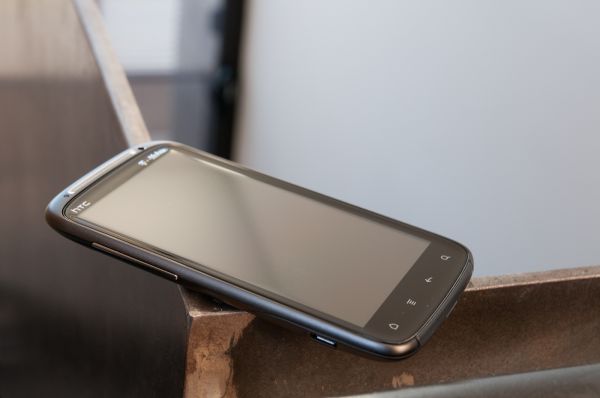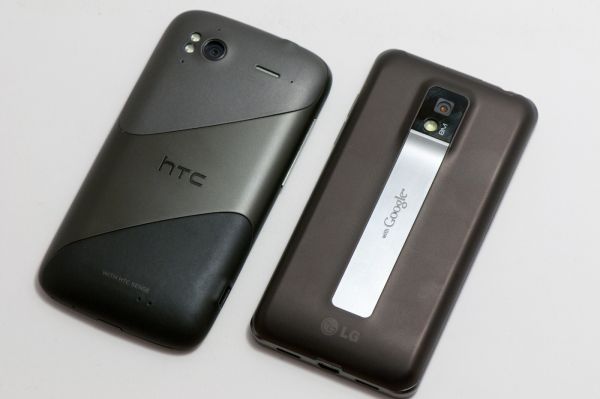HTC Sensation 4G Review - A Sensational Smartphone
by Brian Klug on July 1, 2011 12:38 AM EST- Posted in
- Smartphones
- HTC
- Android
- Mobile
- HTC Sensation
- MSM8260
Battery Life
I generally end up putting battery life details at the end, but to be honest it’s probably one of the most important things on a smartphone, and one of the more important points to explore when talking about the Sensation. This is the second dual core SoC we’ve looked at, and thus the results are even more interesting. Qualcomm’s MSM8260 also differs from NVIDIA’s Tegra 2 in how the SoC scales voltage and frequency. On MSM8x60, each core has its own voltage and frequency plane, meaning that when we’re dealing with a heavy single-threaded workload, the second core can slow down and lower voltage. On Tegra 2, there’s a single voltage and frequency plane across both cores. The latter makes a lot of sense for primarily multi-threaded workloads, since they can be divided across both cores, and voltage is lowered accordingly. Voltage scaling generally wins out in the long run, but right now things in Android have a single-threaded bias.
First up is our cellular web browsing test, where we load a few dozen pages endlessly with the display set to 200 nits until the phone dies. The Sensation posts a very impressive result here scoring a spot at the top of the Android charts.

Next up is WiFi, which is essentially the same thing as our cellular test but connected to an 802.11n AP until the phone dies. Here things strangely aren’t all that great. The Sensation posts a number similar to the cellular test, but compared to other devices doesn’t see a big jump in battery life on WiFi.

Third is the call test, which is pretty self explanatory. We have the phone in test call another device, and play music at both ends to simulate a typical voice call. That runs until the phone dies, and the display is off.

Finally is our newest test, in which we make the smartphone a hotspot, connect up an 802.11n client, and load four tabs of our page load suite alongside a nonstop 128 Kbps audio stream. This simulates a number of people using the hotspot pretty aggressively and doesn’t let the baseband suspend itself. The display is also off.

Here again we see the Sensation take an impressive top position. The comparison I’m looking at is between the Optimus 2X, G2x, and Sensation. As a reminder, the Optimus 2X/G2x both have a 5.6 Whr battery, and the Sensation has a 5.62 Whr battery. The sensation blows away Android competition in the cellular web browsing test and hotspot test, and delivers middling performance in the WiFi web browsing and call test suite.
Conclusion and Final Thoughts
I’m pretty impressed with the Sensation. In most ways, it sets a baseline for what we should expect for this upcoming generation of devices - a dual core SoC, fast connectivity, some sort of specialty display (either high PPI or AMOLED), and unique industrial design that makes the device stand out.
I feel like HTC always is sure to save its best execution for the international version of its handsets, and in this case T-Mobile did the right thing by not messing with it. Beyond the branding on the front and a couple instances of T-Mo purple in the applications list, it really is an international device. Even the band support is the same as the international edition.
The Sensation impresses all around, and has very few shortcomings. First on that list is the absolutely horrendous speakerphone, which seems to either have something broken or the gain set really low in software, and a much more minor second is the small gap at the top which lets pocket lint intrude. Other than that, the only thing I’d seriously change about the Sensation would be to add penta-band WCDMA support so I could buy one and use it in the USA on AT&T for my personal device.
If you’re on T-Mobile, the obvious phone to compare with is the LG G2x, which performs very close to the Sensation and has similar overall size. Where the G2x gets edged out is display size plus resolution, and battery life in some areas. There’s also the fact that the Sensation is shipping with Android 2.3, and the G2x still is officially 2.2, though that’s going to change soon.
Internationally, things get a bit more complicated, since the Sensation is up against the Samsung Galaxy S 2, which we still haven’t taken a formal look at. The competition is fierce, and I'm eager to find out (and maybe even settle) the matter of which one is better.













107 Comments
View All Comments
synaesthetic - Sunday, July 3, 2011 - link
No SGS2 on AWS bands. :(coolhardware - Saturday, July 2, 2011 - link
Nice review. Never thought I'd see a gf discussion be the first comment posts on an AT article ;-)A note on the Sensation, it is supposed to be capable of 1080p MKV playback!
http://www.jdhodges.com/2011/06/can-android-do-108...
And of course the 1080p recording is pimptastic too:
http://www.google.com/search?sourceid=chrome&i...
Overall a pretty sweet phone IMHO :-)
mutu - Saturday, July 2, 2011 - link
pls review Samsung galaxy S2.Penti - Saturday, July 2, 2011 - link
Not to nitpick but why is it even called 4G? It's simply a 14.4Mbps device, we have 32Mbit (advertised speed) HSPA+ for "mobile broadband" here in Sweden, and nobody would care much what speed the cell phone is able to use and nobody tries to pass it as anything else. It's simply called HTC Sensation over here in Europe. Do not yet have 4G in my very little town, but 32Mbit HSPA+ is here. Expect 4G even out here in this market within a year or so though. Sooner in neighboring towns. Guess it's a good thing AT&T are picking up T-mobile USA. We will still need HSPA/+ for a while, but we are quickly moving on. Sure you could also opt for a WiMAX 16m network and the handsets is about as immature, but you need to be building your next gen network now.synaesthetic - Sunday, July 3, 2011 - link
The "4G" is T-Mobile US silly marketing speak that means nothing, of course. They tack 4G on the end of every phone with an HSPA radio capable of more than 7.2Mbps peak downstream.Penti - Sunday, July 3, 2011 - link
Yeah I know that, but why not just call it "Our old network till we get picked up by AT&T"? It's clear why they are without a next gen plan. Their customers need to be picked up by another operator for that to happen.synaesthetic - Sunday, July 3, 2011 - link
Until it's unlocked, I won't buy it.tejagamer - Sunday, July 3, 2011 - link
Excellent Review.. As usual..Now waiting for your comparison of SGS2 vs O2x vs Sensation and the SGS2 review..
bubblesmoney - Sunday, July 3, 2011 - link
Hi Brian,When you review the SGS2 please compare the internal memory on it to the internal memory available on other top of the line android handsets. This is an important limitation on android handsets which are not rooted +/- rommed to overcome the app2internal memory problem of android. Full time Android users [not part time android reviewers :) ] will appreciate what i mean. None of the reviews of android handsets bother to cover this problem users of stock handsets face if they dont root their handsets.
Handsets made by the likes of HTC severely skimp on the internal memory, more specifically the internal memory partitioned and kept for loading apps. On just a year old HTC Desire the partition available for apps is just a measly 147mb. Even on the HTC sensation it is just about 1gb. Compare this to the year old samsung galaxy s which has 1.8gb available for apps. The samsung galaxy s2 also has about 1.9gb available for apps from its 16gb/32gb internal memory. The HTC low internal memory problem does not go away by buying a 32gb card as the card is useless for apps that go on internal memory. The only option on HTC handsets which ALWAYS come with low internal memory compared to the competition (internal memory partition available for apps) is to buy a non HTC handset or to root and get rid of the problem or to use the sdk method described on xda forums.
For a reviews of android handsets it is vital that the internal memory is compared too in a comparison chart and more specifically the internal memory available for apps need comparing too. Please exclude the useless microsd cards supplied with handsets as that is useless for apps that dont go to sd card. Hope you provide such comparison charts for future reviews of android handsets. When games by gameloft etc run into many MBs on internal memory, having internal memory of the likes of 147mb available for apps on the HTC desire will be crucial information especially for many android handset buyers.
Similarly the rear speaker quality being poor is another HTC hallmark in my opinion after owning 2 HTC handsets. But not sure if it is just a hardware issue or HTC software issue. But things get better after loading apps with equalisers (poweramp etc) and boosting the gain. This works later even if the said apps are deleted I think.
Software is nothing without good hardware, so i will be keeping away from HTC and go the samsung galaxys2 way. But I guess the compromise is the much poorer GPS reception on samsung galaxy s2 and other handsets made by samsung.
USB on the go needs to be mentioned as well as competitor handstes have this feature but not the HTC sensation.
Accessories like speaker docks, keyboard are an important differentating feature. Just have a look at the HTC website to see if their handsets can even find one speaker dock or even anywhere else on the net. These options will make a difference to buyers and need to be mentioned in handset reviews.
bubblesmoney - Sunday, July 3, 2011 - link
Brian,In another review they seem to be saying the speaker is good. see http://www.gsmarena.com/htc_sensation_vs_galaxy_si... see the link for detailed test results